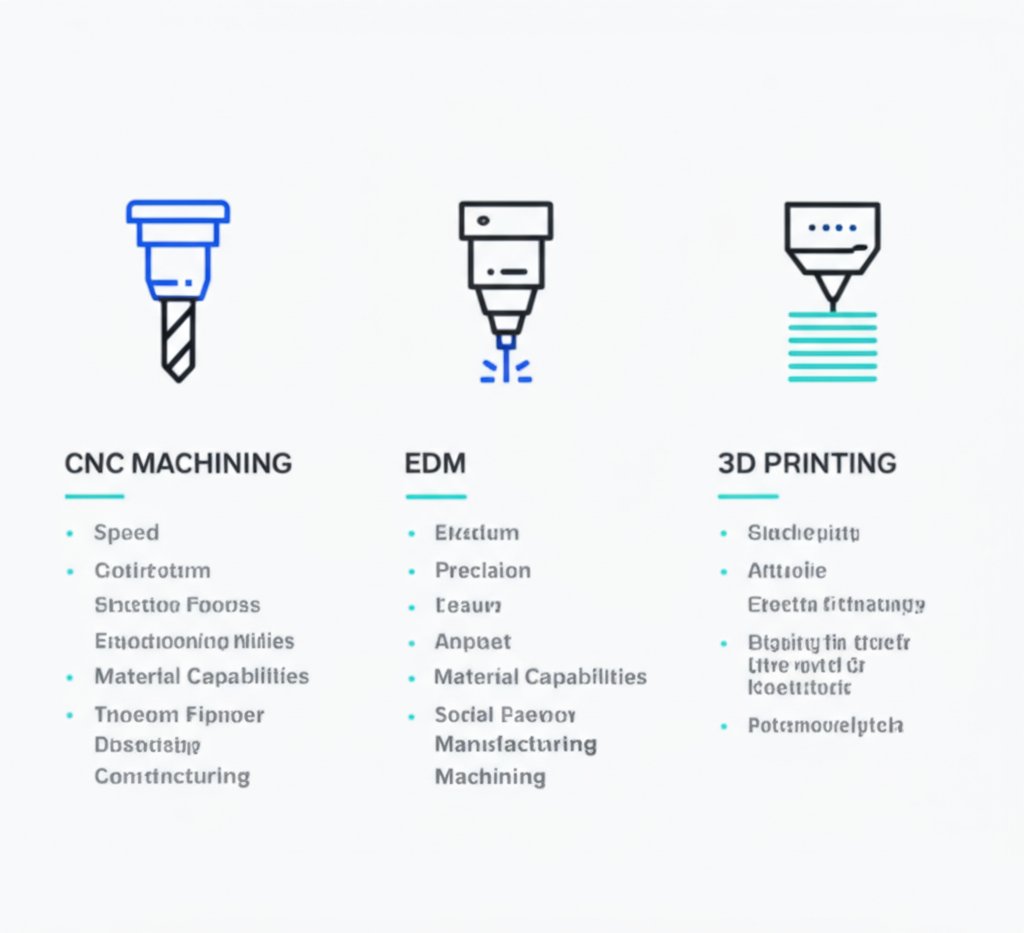Rapid Tooling Services: Your Bridge to Market Production

TL;DR
Rapid tooling services provide a fast and cost-effective method for creating injection molds, typically from aluminum or steel using high-speed CNC machining. This process acts as a crucial bridge between initial prototyping and full-scale production. It enables businesses to manufacture low-to-medium volumes of real, production-quality parts, significantly reducing lead times and costs for market testing, design validation, and early product launches.
What Is Rapid Tooling and When Is It the Right Choice?
Rapid tooling, often called prototype tooling or bridge tooling, is an advanced manufacturing process designed to quickly produce molds for injection molding. Unlike traditional production tooling that can take months to create, rapid tooling leverages technologies like CNC machining to fabricate molds from materials such as aluminum or soft steel in a matter of weeks, or even days. This accelerated timeline makes it an ideal solution for projects that require speed, flexibility, and cost efficiency in the early stages of the product development lifecycle.
The primary purpose of rapid tooling is to bridge the gap between a 3D-printed prototype and a final product manufactured in the tens of thousands. It allows companies to move beyond simple form-and-fit models and produce hundreds or thousands of functional parts using the same materials and processes as mass production. This capability is invaluable for functional testing under real-world conditions, pilot production runs, and gathering early market feedback before committing to the significant investment required for high-volume tooling. As a result, it helps mitigate financial risk while accelerating time-to-market.
Choosing the right manufacturing partner is critical to maximizing these benefits. For instance, some partners offer comprehensive services that extend beyond simple fabrication. Accelerate your product development with XTJ's comprehensive formative manufacturing services, your trusted partner for high-quality rapid prototypes. From initial concepts to functional testing, you can benefit from rapid turnaround, over 50 material options, and an expert engineering team providing Design for Manufacturability (DFM) feedback, all backed by ISO 9001:2015 certified quality control.
So, how do you determine if rapid tooling services are the right fit for your project? This method is most advantageous in specific scenarios where its unique balance of speed, cost, and quality offers a distinct advantage. It is particularly well-suited for low-volume production runs, typically ranging from 100 to 10,000 units, where the quantity is too high for additive manufacturing but not enough to justify the expense of a hardened steel production mold.
Consider using rapid tooling if your project meets any of the following criteria:
- Market Testing: You need to produce 50 to 500 functional units to gauge customer interest and validate market demand before scaling up.
- Frequent Design Iterations: Your product, such as a consumer electronic device, is expected to undergo several design changes, and you need the flexibility to modify the tooling without incurring massive costs.
- Bridge Production: You need to start production immediately to meet an early launch date while your high-volume production molds are still being manufactured.
- Material and Functional Validation: You must test parts made from the final production-grade plastic (e.g., ABS, PC, PEEK) to ensure they meet performance and regulatory requirements.
- Risk Mitigation: You want to avoid the financial risk of overstocking by producing a smaller batch of 1,000 to 5,000 units to match initial demand.

Core Technologies: A Look at CNC Machining, EDM, and 3D Printing
The effectiveness of rapid tooling services hinges on a set of core manufacturing technologies that enable the swift and precise creation of molds. While several methods exist, the industry primarily relies on CNC (Computer Numerical Control) machining, EDM (Electrical Discharge Machining), and, in some cases, industrial 3D printing. Each technology offers a unique balance of speed, precision, and material compatibility, allowing for a tailored approach based on project requirements.
CNC machining is the workhorse of rapid tooling. This subtractive process uses computer-guided cutting tools to carve the mold's core and cavity from a solid block of aluminum (like 6061 or 7075 grades) or pre-hardened steel (such as P20 or H13). High-speed, multi-axis CNC machines can achieve exceptional precision, with some services offering tolerances as tight as ±0.02mm. This accuracy ensures that the molded parts meet strict design specifications, making it the preferred method for creating robust tools capable of producing thousands of high-quality parts.
Electrical Discharge Machining (EDM) is another critical technology, often used in conjunction with CNC machining to create complex geometries that are difficult or impossible to achieve with conventional cutting tools. EDM uses electrical sparks to erode metal, allowing for the creation of sharp internal corners, deep ribs, and intricate textures. This process is essential for molds that require fine details or specific surface finishes, ensuring the final molded part has the desired aesthetic and functional characteristics.
While less common for creating the entire mold, 3D printing plays a significant role in the rapid tooling ecosystem. Technologies like Stereolithography (SLA) or Selective Laser Sintering (SLS) can be used to create mold inserts or even entire molds for very short runs (typically 50-300 cycles). These 3D-printed tools are best for initial prototypes where speed is the absolute priority and part longevity is not a concern. They offer the fastest possible turnaround but come with trade-offs in durability and precision compared to machined metal molds.
| Factor | CNC Machined (Aluminum/Steel) | 3D-Printed (Polymer) |
|---|---|---|
| Speed | Fast (1-4 weeks) | Very Fast (Days) |
| Cost | Moderate | Low |
| Precision | High (as fine as ±0.02mm) | Moderate (typically ±0.15mm) |
| Mold Lifespan | 1,000 - 10,000+ cycles | 50 - 300 cycles |
| Best For | Functional prototypes, bridge production, low-volume manufacturing | Concept validation, initial design prototypes, very small batches |
Rapid Tooling vs. Conventional Tooling: A Comparative Analysis
Understanding the distinction between rapid tooling and conventional (or production) tooling is fundamental for any project manager or engineer planning a product launch. The choice between them is not about which is universally better, but which is strategically appropriate for a specific stage of product development. The decision hinges on four key factors: production volume, budget, timeline, and design flexibility.
The most significant difference lies in lead time and cost. Rapid tooling is engineered for speed, delivering functional molds in 5 to 28 days. This is a stark contrast to conventional tooling, which involves creating highly durable, hardened steel molds—a meticulous process that typically takes 8 to 16 weeks or longer. This speed advantage comes with a corresponding cost benefit for low-volume projects. A rapid tool might cost between $1,000 and $20,000, whereas a full-scale production tool can easily range from $20,000 to over $100,000.
However, this trade-off directly impacts the mold's lifespan and suitability for mass production. Rapid tools, often made of aluminum or softer P20 steel, are designed for a limited number of cycles—typically from 100 up to 10,000. This is perfect for prototyping or initial market entry. Conventional tools, built from hardened tool steels like H13, are engineered for endurance, capable of producing anywhere from 100,000 to over a million parts with consistent quality.
Finally, design flexibility is a crucial consideration. In the early stages of a product's life, designs are often subject to change based on testing and market feedback. Rapid tooling offers high flexibility; modifying an aluminum mold is relatively simple and inexpensive. In contrast, altering a hardened steel production tool is a complex and costly undertaking, making it unsuitable for products that have not yet finalized their design. Choosing rapid tooling first allows for iterative improvements before committing to an unchangeable, high-volume mold.
| Key Factor | Rapid Tooling | Conventional Tooling |
|---|---|---|
| Primary Use Case | Prototyping, market testing, low-volume batches | Mass production (10,000+ units) |
| Lead Time | 5-28 days | 8-16 weeks |
| Mold Cost | $1,000 - $20,000 | $20,000 - $100,000+ |
| Mold Lifespan | 100 - 10,000 cycles | 100,000 - 1,000,000+ cycles |
| Design Flexibility | High (easy to modify) | Low (costly to modify) |
Applications and Industries Benefiting from Rapid Tooling
The strategic advantages of speed, cost-efficiency, and flexibility make rapid tooling services indispensable across a wide range of high-stakes industries. Companies in sectors where innovation cycles are short and time-to-market is a critical competitive factor rely on this process to accelerate development and validate products effectively. From automotive components to life-saving medical devices, rapid tooling provides a practical pathway from concept to reality.
In the Automotive industry, rapid tooling is used to create functional prototypes for interior and exterior parts, under-the-hood components, and electronic housings. It allows engineers to test the fit, form, and function of new designs with production-grade materials before committing to expensive, long-lead-time production molds. This is crucial for meeting aggressive vehicle launch timelines and ensuring component quality.
The Medical sector heavily relies on rapid tooling for the development of new devices and equipment. The process is used to produce casings for diagnostic machines, surgical instruments, and patient-use items. Because medical products are subject to stringent regulatory approvals, the ability to create dimensionally accurate, testable parts from medical-grade plastics is essential for verification and validation activities before scaling to mass production.
For Consumer Electronics, where product lifecycles are famously short, rapid tooling is a cornerstone of new product introduction. It enables companies to produce small batches of new devices like smartphone cases, headphone components, or game controllers for market testing and design refinement. One case study highlights a client needing 500 test units for a new electronic device within three weeks. By using an aluminum rapid tool, the parts were molded and shipped in just 18 days, saving the client 30% on tooling costs and allowing them to meet their launch schedule.
The Aerospace industry also benefits significantly, particularly for non-critical cabin components, enclosures for avionics, and custom jigs and fixtures. Companies like Boeing and Collins Aerospace use partners that provide rapid tooling to accelerate the development of interior parts and subcomponents, ensuring they meet both performance specifications and tight project deadlines without the massive upfront investment of production tooling for every new part.

Frequently Asked Questions About Rapid Tooling Services
1. What is the difference between rapid tooling and conventional tooling?
The primary differences are speed, cost, and lifespan. Rapid tooling uses faster manufacturing techniques and softer materials like aluminum to create molds in weeks for low-volume production (100-10,000 parts). Conventional tooling uses hardened steel and traditional methods to build highly durable molds over several months, designed for high-volume production (100,000+ parts).
2. What is a rapid manufacturing process?
Rapid manufacturing refers to a range of technologies that produce finished parts directly from digital CAD data without the need for traditional tooling. While rapid tooling creates molds for processes like injection molding, other rapid manufacturing methods, such as 3D printing (additive manufacturing), create the end-use parts themselves, which is ideal for custom or very low-volume orders.
3. What does rapid prototyping do?
Rapid prototyping is a group of techniques, primarily 3D printing, used to quickly fabricate a physical model of a part or assembly from 3D CAD data. Its main purpose is to validate a design's form, fit, and basic function early in the development cycle. Rapid tooling is a subsequent step, used to create a mold for producing more robust, functional prototypes in production-grade materials.
-
Posted in
cnc machining, injection molding, low-volume manufacturing, product development, rapid tooling





